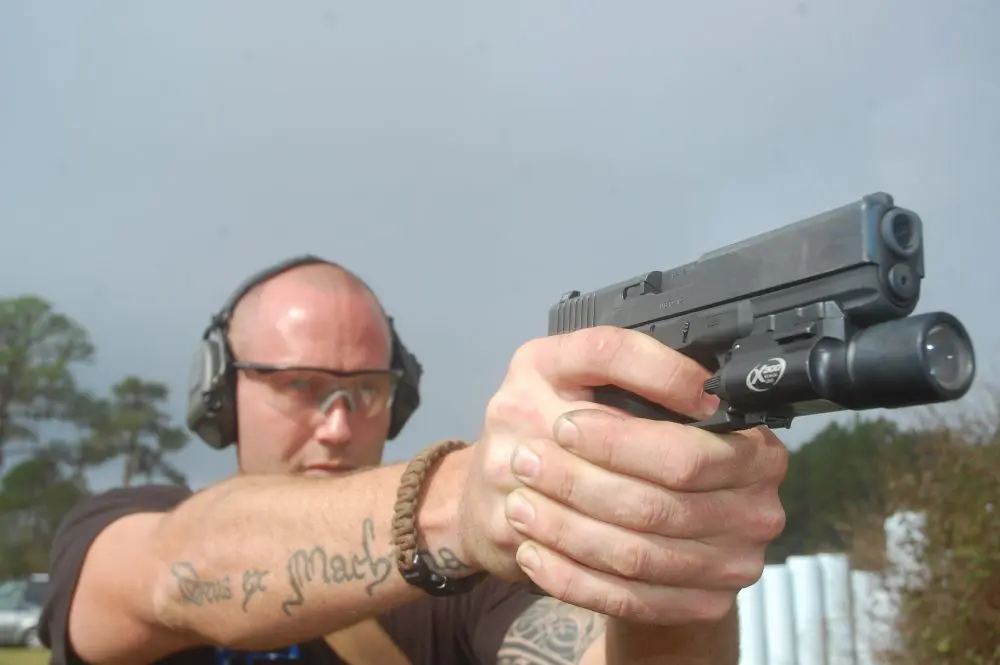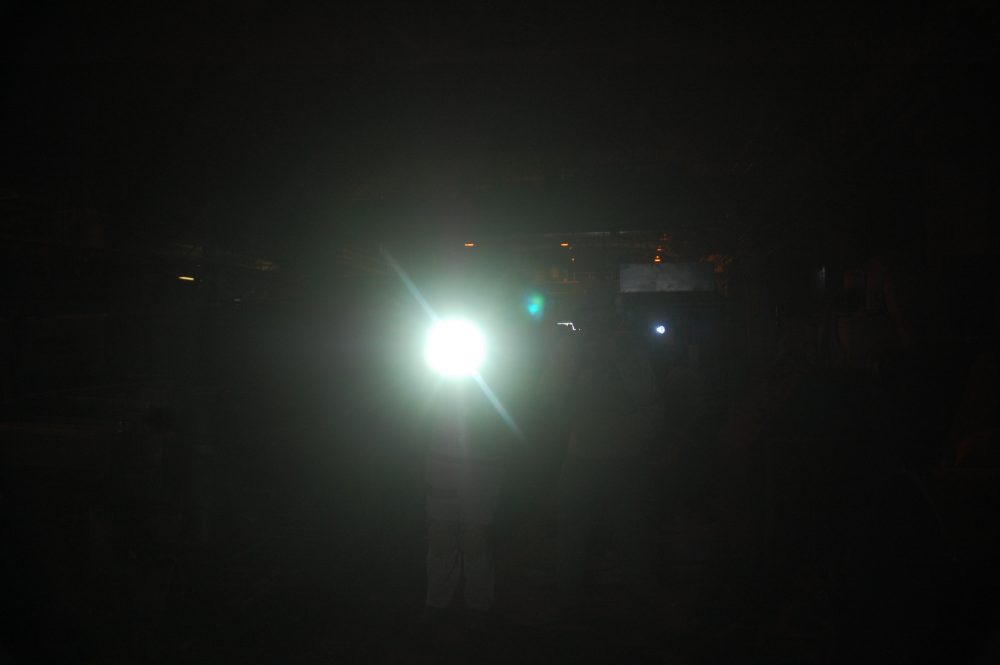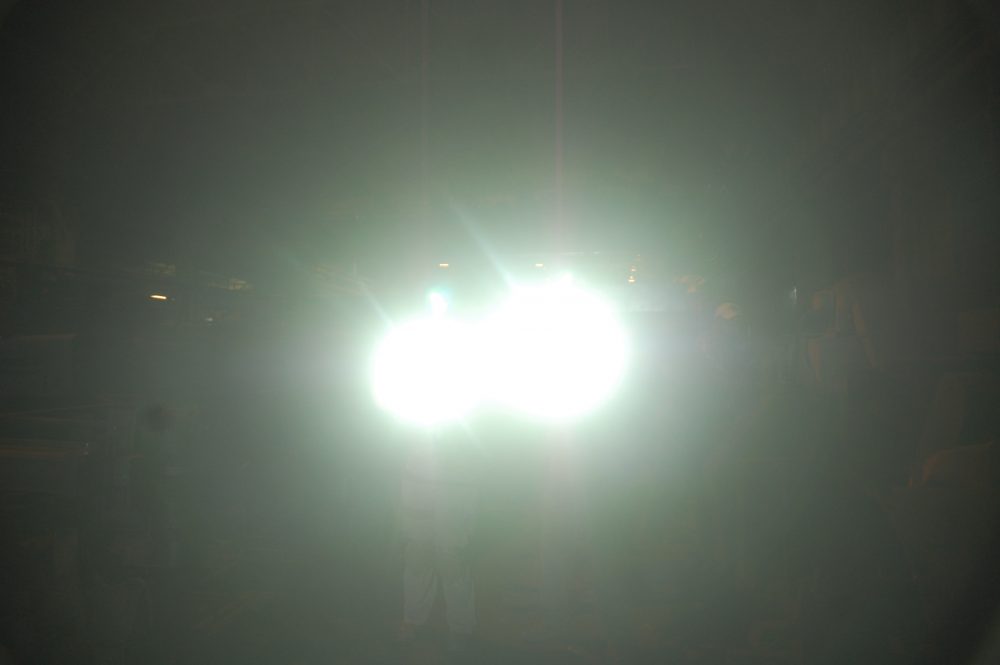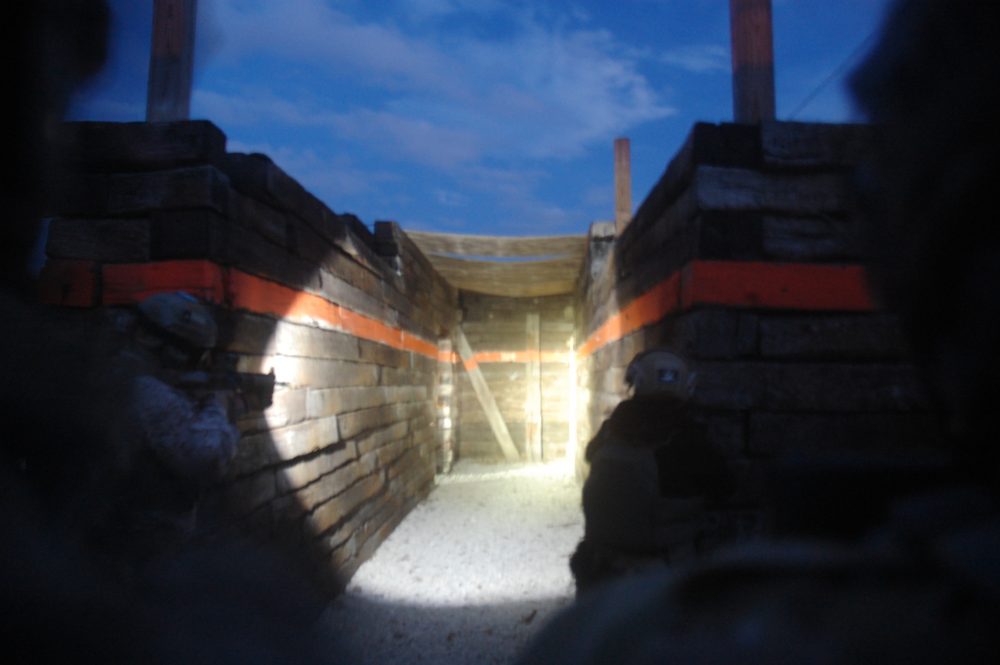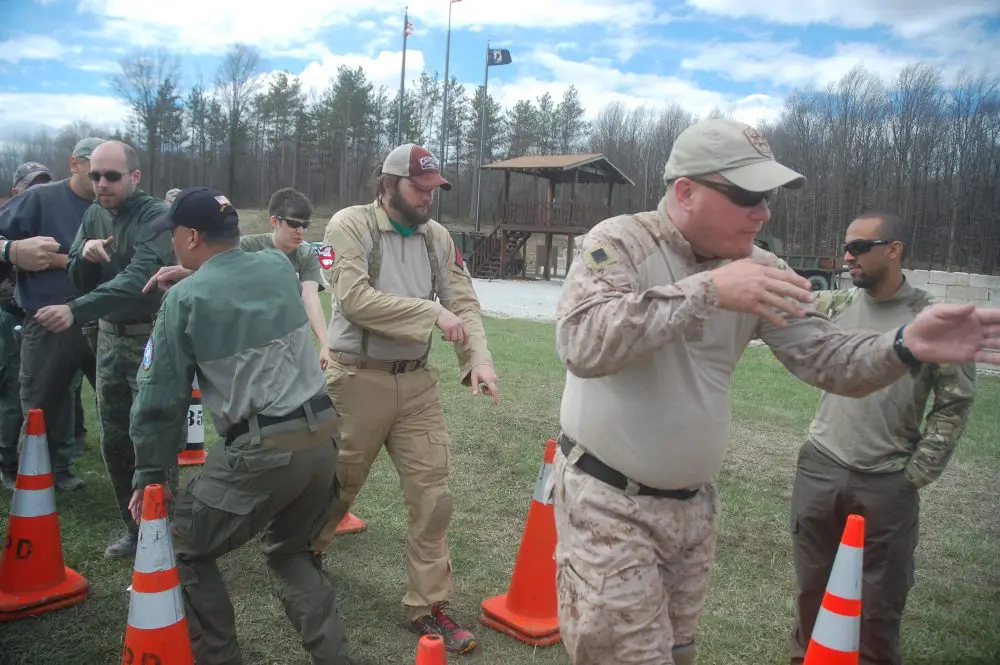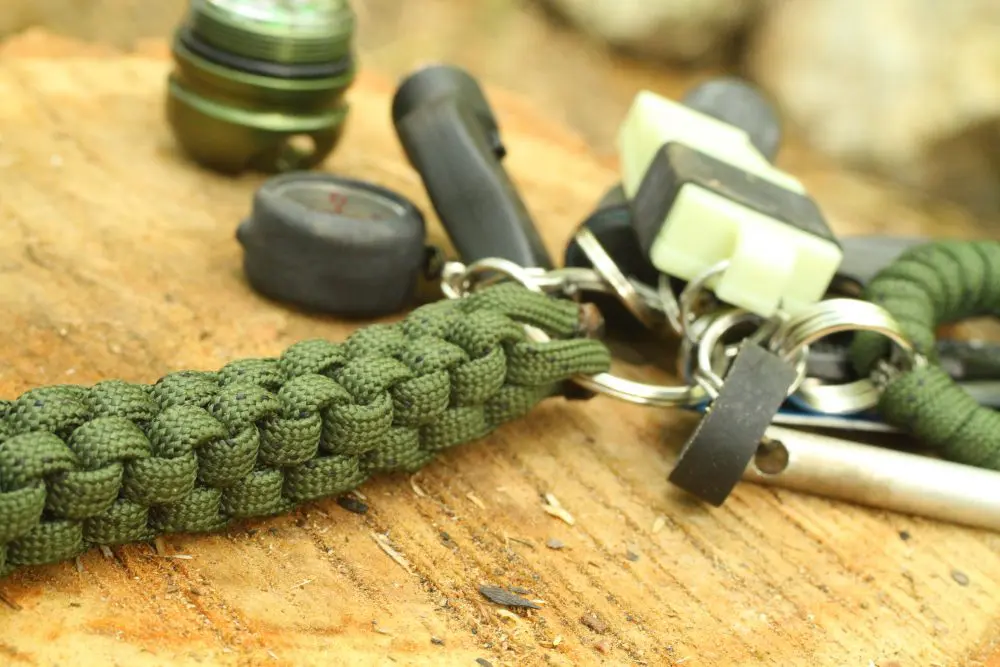Ben Simonsen of Boresight Solutions runs his Glock with SureFire X300.
The target engagement process begins with acquiring a target. Someone has your attention. The second step is identification—the ability to discriminate between a good guy, a bad guy, or someone unknown. If it is a bad guy, you have to further discriminate if he is armed, and if deadly physical force is required.
During daylight—when 99.9% of training is conducted—targets are pretty easy to see. And identification is easy, as you are most often shooting at the same target you have been shooting at for however long you have been shooting. Discriminating between shoots and no shoots isn’t normally your problem on the square range because the rangemaster will tell you who to shoot, when to shoot, and how many times to shoot.
And low-light shooting? Not a problem, because the same rangemaster has you all line up and take out your handheld lights and turn them all on at the same time—creating enough light for the Space Shuttle to land on the firing line.
Oh, that’s right. We no longer have a Space Shuttle…silly me.
Anyway, in most agencies, people use a handheld light in conjunction with their pistol to illuminate the target. And the last time I checked, we normally have two hands. However, most people suck at shooting a handgun. Most people suck badly when shooting one handed. And people really, really suck when trying to perform separate tasks with each hand.
Lt. Col. Joseph Halloran IV (left) and Lt. Col. Bill Peterson (right) make ready at Alliance, Ohio PD shoot house. Both are very experienced shooters, and both have SureFire X300U—a 500-lumen light—on their pistols.
Table of Contents
WMLs: WHY THE HATE?
So why don’t we have weapon-mounted lights (WML)? It should be a no brainer on patrol rifles—after all, there are no truly useful handheld techniques available for long guns.
Pistols are a different ball of wax. Pistols are always going to be more difficult to shoot, no matter what. Why all the animosity directed at weapon-mounted lights on pistols? The first reason has some validity. Some believe the light will be used improperly. There is no doubt this is true. Just like when people use their firearms improperly. Or their cars. Or their reproductive organs.
The key of course is training, which brings competence, confidence and self-control. But training is difficult and expensive and therefore beyond the ken of most who carry guns. Maybe we need to understand why we have that gun in the first place. It is to defend you or a third person from an attack by another. Some would have us believe it is to hunt with or engage in competitions with, and while those may be useful byproducts, that was not the Founding Fathers’ intent.
Two shooters inside a factory in daylight…
So if we need to use the weapon (and that is what it is—a weapon), we need to use it in the most efficient manner possible. That means we must rapidly and accurately fire the shots necessary to incapacitate the opponent(s).
Putting a handheld light in one hand and a gun in the other makes things more difficult. But if we have a WML, the shooting thing is more intuitive. Some are offended that you might be searching with that WML. True enough, but let’s be realistic. If I drop my car keys, I am using a handheld light. That makes sense.
But if I am searching for someone in my house—and understanding that I have good situational awareness on my better half and faithful dog—I am searching with that gun/WML combo. Because anyone in my house without permission or authority to do so is a criminal, and he is in my house to commit a crime. Therefore hunting with the WML makes sense.
If I have to use deadly physical force, I am ready to do it efficiently and will not have to fumble around trying to get the light and gun into play.
…one pointing a single 500-lumen Fury light…
WML HISTORY
The first WMLs were generally a Streamlight or Maglight taped or attached to the gun—usually a sub-caliber machine gun or M16—with hose clamps.
The revolution occurred when Laser Products (now SureFire) came up with what was later known as a 6P, a small lithium-powered light that, according to their advertising, put out a “blinding” 60 lumens.
It was a start.
The state of the art has advanced, and while SureFire is still the king of this hill, others are producing WMLs for carbines as well. As part of that advancement, the incandescent bulb finally went the way of the dodo and was replaced with high-powered LEDs, which meant no bulb breakage and more light. We now have a number of lights available that are smaller, lighter and much more powerful than their predecessors. Lights for both the pistol and the long gun are normally mounted on the MIL-STD 1913 rail.
…both pointing Fury lights during LMS CQB Operations Course in Alliance, Ohio. This is a force-on-force course, and the efficiency of the light is obvious. The light is not a weapon—it is an illumination tool.
Some companies make a Universal rail, which is similar to a Weaver Rail. Some lights come with adapters to fit both systems. Worse, some pistol companies make a proprietary rail that will accept only their crappy proprietary light. This will forever lock you in to a legacy light, while the rest of the world passes you by.
If something is made to a particular standard, there is a reason for it and it will likely function as desired. If it is not built to a standard, it’s because the manufacturer is cutting corners by reducing manufacturing costs or using substandard materials.
WMLs ON PISTOLS
Back to pistols, which are a contentious subject. While all pistol lights mount the same way—on a rail or rail adapter in front of the trigger guard—the switchology is different.
Most lights have a toggle switch of some type on the rear of the light. You can generally turn the light on “constant” by rotating the toggle in either direction. For some units, using it in the “momentary” mode is accomplished by a push on the side of the toggle. This type of switch requires you to use either your trigger finger or a finger of your support-side hand to activate the switch. Using the trigger finger can be clumsy, and might be a problem if:
A: you don’t shoot when you are supposed to.
or
B: you shoot when you are not supposed to.
Two shooters, each using a 500-lumen Fury, illuminate hallway. Amount of light downrange is impressive.
Using your support-side hand is good, unless that support-side hand is busy doing something else. Then you are pretty well screwed.
The WML with a laser uses a bi-lateral button to operate the light and visible laser, but the same rules apply. SureFire has another option: the DG Slim Line Switch. This is a replacement battery cover that has a slender bar that goes under the trigger bar and down the frontstrap of the pistol. The Slim Line Switch is a small protuberance under your social finger. To activate the light, you need to do nothing but acquire a firing grip.
There are some who claim that acquiring a firing grip leads to a sympathetic response, which leads to an ND, and that is true if the shooter has his finger in the trigger guard when it should not be. Others complain that the DG Switch leads to the dreaded “white light ND.” Got it. But if I am bringing the pistol out of the holster for real, having the light on is a non-issue. And if I want to keep the light off so as not to give away my position, I’ll just gently relax my middle finger a bit.
Shooting while using a handheld light means it is more complex to use. Your shooting is slower and less accurate than if employing a WML. Officers at Montgomery County, Pennsylvania range facility train in handheld techniques.
Some complain about the switch, stating that it forces them to alter their grip. Really? The switch is only .20-inch thick. I have what Larry Vickers calls cadet-sized hands and don’t have any issues. But I understand that some are more sensitive to certain things, so I won’t discount it, but I believe this to be a non-issue as well.
SureFire used to have another switch for their X series—the TG Switch. This switch was similar to the DG Switch but went under the trigger guard only. To activate the light, you exerted pressure upward. It was not intuitive and didn’t last very long.
AUTHOR’S CHOICES
What do I use? I am a strong proponent of WML on my long guns as well as my handguns. The primary purpose of those WMLs is to acquire, identify and if necessary, process a threat. To that end, I want a single-function light—no strobes, default to low power or any other bling. I also want the light on the big gun to have the ability to have an on/off clicky switch so I can still have light if I take my support-side hand off the gun.
On my work pistols, Smith & Wesson M&P 9mms, I run a SureFire X300U with DG-12 Switch. And on my work carbines—BCM EAG and HS guns, as well as the student guns—I run a SureFire Fury in a LaRue Tactical 606-1 mount. Both of these put out 500 lumens of light, and that is what I consider to be most useful across the broad spectrum of need.
The Fury has what I believe to be the optimal reflector available, in that it does not only have a definite hotspot for reach, but the spill area can also illuminate rooms large and small. This increases your SA in that the WML does not have to be directly on your target to see it. Being able to illuminate a wide area gives you a major SA boost, which goes a long way toward your winning the fight.
Author’s primary work gun, M&P 9mm VTAC Model. X300U light is operated primarily by SureFire DG-12 switch. Rocker switch can also be used. If you push the rocker up/down, you will have constant on. Pushing gently forward on either side will give you momentary light.
Contrary to popular mythology, 500-lumen lights won’t “blind” you. If they did, there would be a lot more guys with white canes, and SureFire would have a metric buttload of lawsuits awaiting payment.
If pointed at you, however, it can disorient you—which is the second priority of that light. We hear from some tactical teams that “we don’t need more than 100 lumens—we only do entries.”
News flash: In your town, is there a school? A hospital? A factory? A Wal-Mart? Because if there is, you will likely have shots to at least 100 yards and in some cases, up to 200 yards. “Entries” is a poor word to hang your helmet on. I would prefer to have a light that I can use out to the useful range of the gun.
I’ll add this: you must have a handheld light in addition to any WML you’re running. You need to know and train with handheld light techniques in the event your WML goes tango uniform, and you will need the light for more mundane uses.
What works for me may or may not work for you. Be guided by two facts: the mission drives the gear train, and the best gear in the world is useless without training.
Pat Rogers is a retired Chief Warrant Officer of Marines and retired NYPD Sergeant. Pat is the owner of E.A.G. Inc., which provides services to governmental organizations and private citizens. He can be reached at [email protected].
SOURCES:
Inforce
(401) 294-2050
www.inforce-mil.com
Insight Technology
(866) 509-2040
www.insighttechnology.com
Laser Aiming Systems Corporation
(800) 990-9390
www.viridiangreenlaser.com
Streamlight®, Inc.
(800) 523-7488
www.streamlight.com
SureFire, LLC
(800) 828-8809
www.surefire.com
